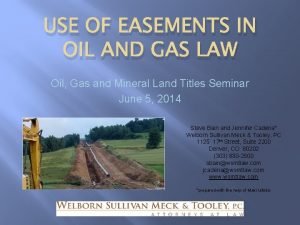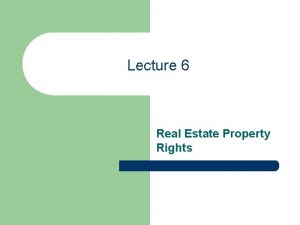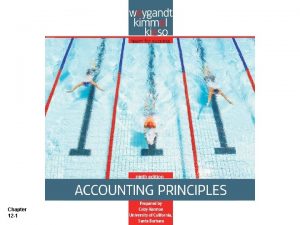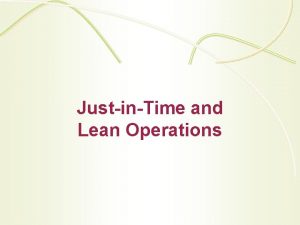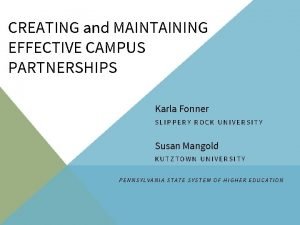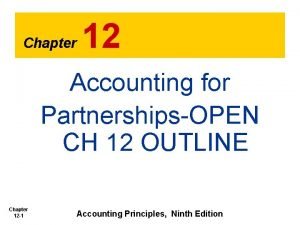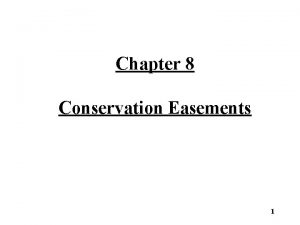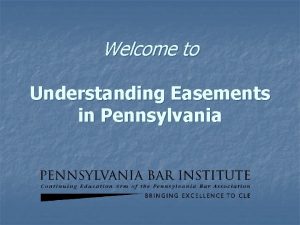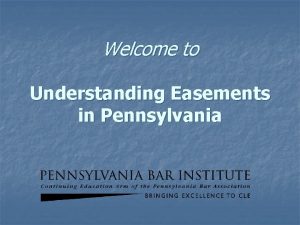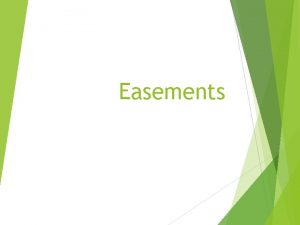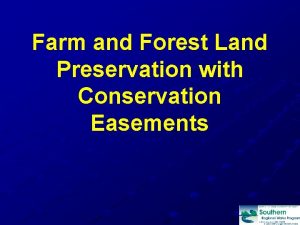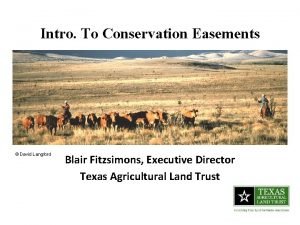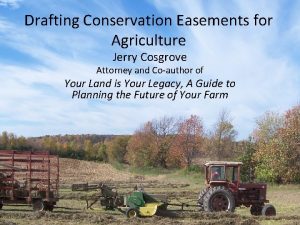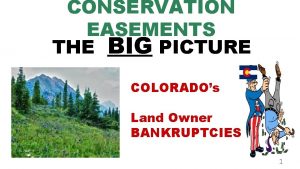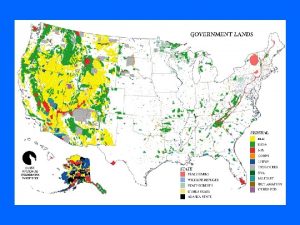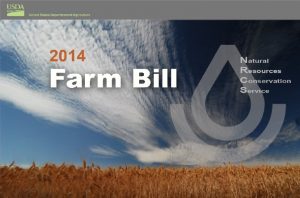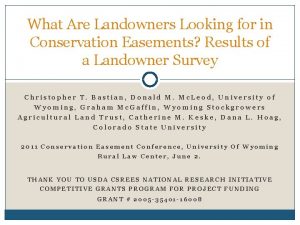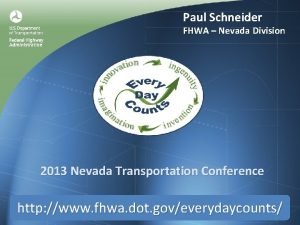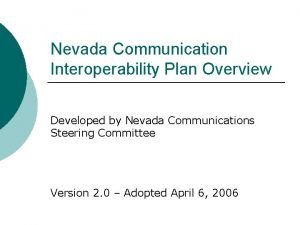Nevada Conservation Credit System Partnerships for Conservation Easements






























- Slides: 30

Nevada Conservation Credit System: Partnerships for Conservation Easements Workshop: Reno, NV – September 12, 2017 Kelly Mc. Gowan, SEP Manager

Overview 1) The Sagebrush Ecosystem Program 2) General Overview of the Conservation Credit System (CCS) 3) Introduction to the Habitat Quantification Tool (HQT) 4) Introduction to Polices in the CCS Manual 5) CCS Funding and Trainings

Sagebrush Ecosystem Council (SEC) Nine Voting Members Six Ex-Officio Members J. J. Goicoechea, Chair – Local John Ruhs – BLM Government Chris Mac. Kenzie, Vice-Chair – Wildlife Commission Allen Biaggi – Mining Steve Boies – Ranching Gerry Emm – Tribal Nations Starla Lacy – Energy Bevan Lister – Agriculture Tina Nappe – Conservation & Environmental Sherm Swanson – General Public Carolyn Swed – USFWS Bill Dunkelberger – USFS Ray Dotson - NRCS Bradley Crowell – DCNR Tony Wasley – NDOW Jim Barbee – NDA

Sagebrush Ecosystem Technical Team (SETT) Kelly Mc. Gowan – Program Manager Katie Andrle – Department of Wildlife Daniel Huser – Division of Forestry Vacant – Department of Agriculture Vacant – Division of State Lands

Overview 1) The Sagebrush Ecosystem Program 2) General Overview of the Conservation Credit System (CCS) 3) Introduction to the Habitat Quantification Tool (HQT) 4) Introduction to Polices in the CCS Manual 5) CCS Funding and Trainings


Goal of the CCS To offset impacts from anthropogenic disturbances through the implementation of enhancements and protections that result in a net conservation gain or no net-loss for Greater Sage-grouse in Nevada.

Nevada CCS Overview Measures habitat value in units of functional acres (quality and quantity) Credits are the currency of the CCS Credits are based on functional acres and polices in the Manual Credits are used to offset debits. The same methods are used to determine both. Credit Developers sell credits directly to Credit Buyers The price of credits is determined by free market forces (there is no price set for credits)

The CCS – How it Works The Credit System The Credit Developer and Buyer agree on a purchase price and credits are sold. The Administrator (SETT) tracks the transfer of credits to ensure net conservation gain The Credit Developer A landowner commits to conserve sagegrouse habitat for a duration of time, which generates credits they can sell. Credits are verified using the CCS. The Credit Buyer A project proponent on BLM or USFS lands uses the CCS to determine the number of credits needed to fulfill mitigation requirements.

Overview 1) The Sagebrush Ecosystem Program 2) General Overview of the Conservation Credit System (CCS) 3) Introduction to the Habitat Quantification Tool (HQT) 4) Introduction to Polices in the CCS Manual 5) CCS Funding and Trainings

Site Scale Vegetative characteristics at location of proposed activity necessary for sage-grouse life cycle requirements Three different seasonal habitat types: Breeding, Late Brood-Rearing, and Winter

Local Scale Habitat surrounding a proposed project site Purpose to quantify the extent to which the surrounding landscape affects the site’s ability to perform up to its full potential – “putting the site in context” Local scale quantifies: § § Anthropogenic Disturbances Habitat Suitability Index Distance to Lek (Breeding) Distance to Late Brood. Rearing (Breeding)

Landscape Scale Provides information for targeting management actions (credits and debits) Factor Multipliers: § Management Importance (PHMA, GHMA, OHMA) § Meadow Habitat Power Factor Proximity Factor (debits only)

Landscape Scale: Meadow Habitat Power Factor Habitat Type Factor Value Meadow 8. 0 This gets at the concept of limiting seasonal habitat, since meadows are generally limited and are important for sage-grouse to complete the LBR life cycle stage Provides incentives for credit projects and disincentives for debit projects

Overview 1) The Sagebrush Ecosystem Program 2) General Overview of the Conservation Credit System (CCS) 3) Introduction to the Habitat Quantification Tool (HQT) 4) Introduction to Polices in the CCS Manual 5) CCS Funding and Trainings

Conservation Credit System Policies Overview

Credit Service Area

Credit Project Types Habitat Stewardship – enhancement or preservation § Preservation: maintenance and active management of high quality habitat § Enhancement: improvement of habitat to increase habitat functionality ex) meadow enhancement, Phase I PJ removal Habitat Restoration – reestablishing degraded or nonfunctioning habitat ex) restoration after rangeland fire Anthropogenic Disturbance Removal - ex) powerline removal in otherwise functional habitat

CCS Additionality Definition Credit Developers must demonstrate that a potential credit project site will provide additional benefit to sage-grouse above and beyond those generated through the application of existing federal funds or participation in other credit markets.

Credit Site Protection All participating credit projects are required to complete and sign a Participant Contract, a legal agreement and accompanying Management Plan, which details: § Monitoring, reporting, and verification requirements; § Credit project duration; § Financial assurance obligations for long-term management and monitoring; § § § Habitat function performance standards; Binds the site to the Management Plan; and Additional relevant terms and conditions Reserve Account Private Land Easements and Public Land ROW or Designations

Credit Project Duration The length of time a Credit Developer has committed to maintaining certain habitat function performance standards. The duration of credit projects can be either limited term or in perpetuity. Limited term credit projects can be renewed after the credit project duration expires. The minimum credit project duration is 30 years and project duration is defined in 5 year increments. Credit buyers must purchase credits that equal the duration of the life of their disturbance

The Reserve Account A percentage of credits generated from all Credit Projects are “deposited” in the Reserve Account based on the risk of credits being invalidated. Credits in the Reserve Account may be used to temporarily cover credits invalidated at other credit sites from intentional and unintentional reversals in order to ensure there always more credits than debits in the CCS, i. e. provides an “insurance policy” for the CCS.

Credit Release for Credit Project Types Habitat Stewardship Credit Projects – occurs when a habitat function performance standard defined in the credit project’s Management Plan is achieved. § Preservation: likely to have a single credit release § Enhancement: may have multiple credit releases Habitat Restoration Credit Projects – occurs when a management action or habitat function performance standards defined in the project’s Management Plan is achieved. § Multiple credit releases occur § No more than the first one third of credits may be released upon implementation of management actions Anthropogenic Disturbance Removal Credit Projects – occurs when a habitat function performance standard is achieved (coincides with management action of removing disturbance).

Credit Site Verification The Verification schedule is based on the credit release schedule defined in each Management Plan, and requires Credit Verification: § Before first credit release (Verifier) § Before additional credit releases (Verifier) § At least every 5 th year (Verifier) § Periodic spot checks and audits (Administrator or relevant public land management agency) § Annual self-monitoring (Credit Developer) Verification is done by certified Verifiers

Financial Assurances Financial assurance are fiscal mechanisms used to ensure durability of credits generated for the full duration of the credit project. Credit Developers are required to establish these & are defined in the Participant Contract and Management Plan. Financial assurances must ensure that funds are available: § For long-term management and monitoring of each credit project, including remedial actions in the event of unintentional reversals Ø A portion of the credit payment is held in a financial instrument and paid annually to the Credit Developer for maintenance and monitoring Ø Financial instruments, such as stewardship funds & contract surety bonds § To promptly replace credits that have been sold but become invalidated due to intentional reversals. Ø Contract terms, such as financial penalties or financial instruments

How much is a credit worth? Credit prices are market-driven Dependent upon many factors: Cost of restoration/conservation project Cost of long term monitoring and maintenance Cost of verification Financial/Legal services Factor in land value/demand/interest Water rights Etc.

Types of Projects that Qualify: Pinyon-Juniper Removal Implementing Grazing Management Seeding Sagebrush Increasing & Protecting Forb Diversity Removing Existing Infrastructure Protecting High Quality Habitat Treatment of Noxious and Invasive Plant Species

Process for Credit Development Validation Checklist Field Verification Management Plan Participant Contract Establish Financial Assurances

Potential Benefits to Landowners Generate Income – Generate income from greater sage-grouse habitat and sagebrush ecosystem enhancement, restoration and preservation on private and public lands Increase Stewardship – Create new and enhance existing stewardship of private lands and public allotments through targeted conservation investments Fund Infrastructure – Infrastructure that improves livestock management (e. g. install fencing around riparian areas, seeding, brush management) while generating benefits for wildlife Preserve Culture – Support the preservation and benefits of the ranching industry and the economy of Nevada

Questions? kmcgowan@sagebrusheco. nv. gov 775 -684 -8600 ext. 28 www. enviroaccounting. com/NVCredit. System www. sagebrusheco. nv. gov
 Dominant vs servient estate
Dominant vs servient estate Dominant and servient easements
Dominant and servient easements This can be avoided by giving credit where credit is due.
This can be avoided by giving credit where credit is due. Accounting for partnerships chapter 12 solutions
Accounting for partnerships chapter 12 solutions Adp accenture
Adp accenture Word partnerships
Word partnerships Product development partnerships
Product development partnerships Characteristics of just-in-time partnerships do not include
Characteristics of just-in-time partnerships do not include Maintaining effective partnerships
Maintaining effective partnerships Publicpartnerships.com login
Publicpartnerships.com login Epsrc prosperity partnerships
Epsrc prosperity partnerships Chapter 12 accounting for partnerships answers
Chapter 12 accounting for partnerships answers Characteristics of hire purchase system
Characteristics of hire purchase system Formuö
Formuö Typiska novell drag
Typiska novell drag Tack för att ni lyssnade bild
Tack för att ni lyssnade bild Returpilarna
Returpilarna Varför kallas perioden 1918-1939 för mellankrigstiden?
Varför kallas perioden 1918-1939 för mellankrigstiden? En lathund för arbete med kontinuitetshantering
En lathund för arbete med kontinuitetshantering Adressändring ideell förening
Adressändring ideell förening Tidbok för yrkesförare
Tidbok för yrkesförare Anatomi organ reproduksi
Anatomi organ reproduksi Förklara densitet för barn
Förklara densitet för barn Datorkunskap för nybörjare
Datorkunskap för nybörjare Boverket ka
Boverket ka Hur skriver man en debattartikel
Hur skriver man en debattartikel Delegerande ledarskap
Delegerande ledarskap Nyckelkompetenser för livslångt lärande
Nyckelkompetenser för livslångt lärande Påbyggnader för flakfordon
Påbyggnader för flakfordon Vätsketryck formel
Vätsketryck formel Svenskt ramverk för digital samverkan
Svenskt ramverk för digital samverkan
